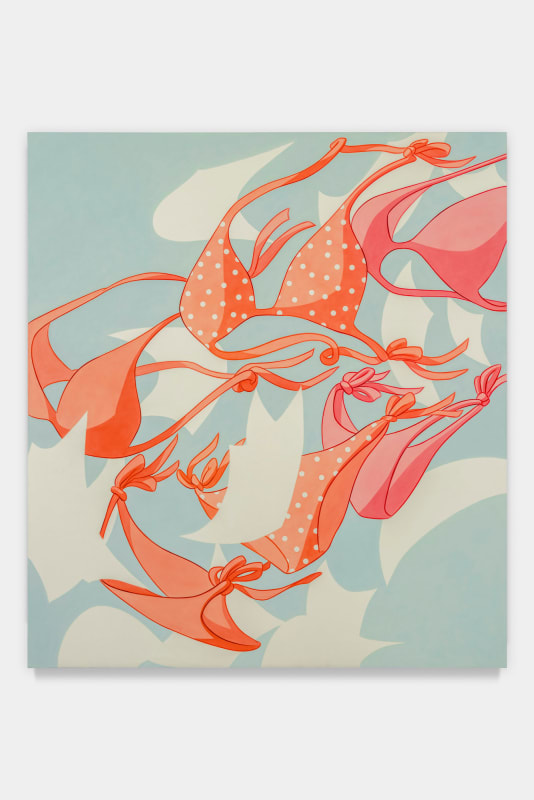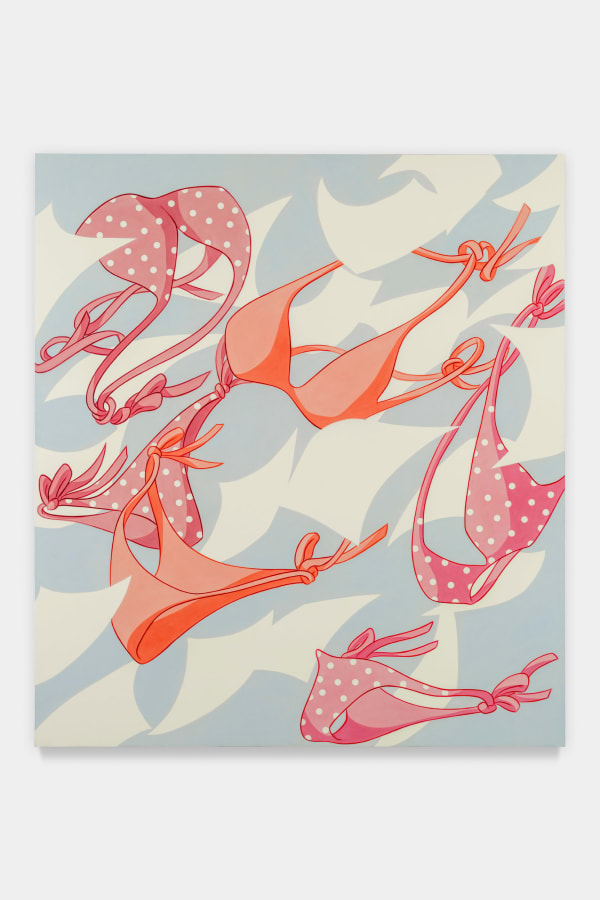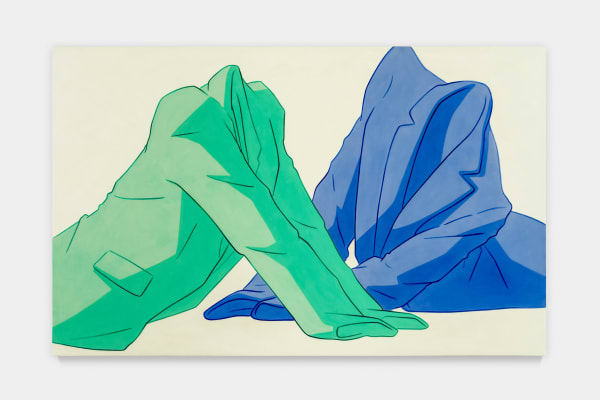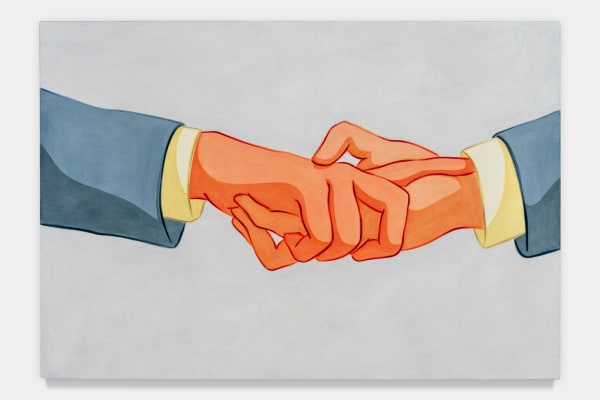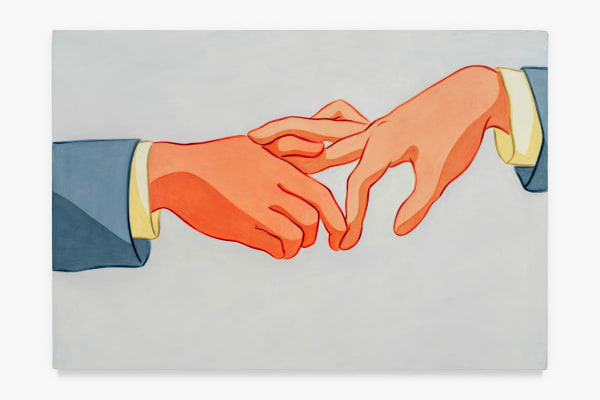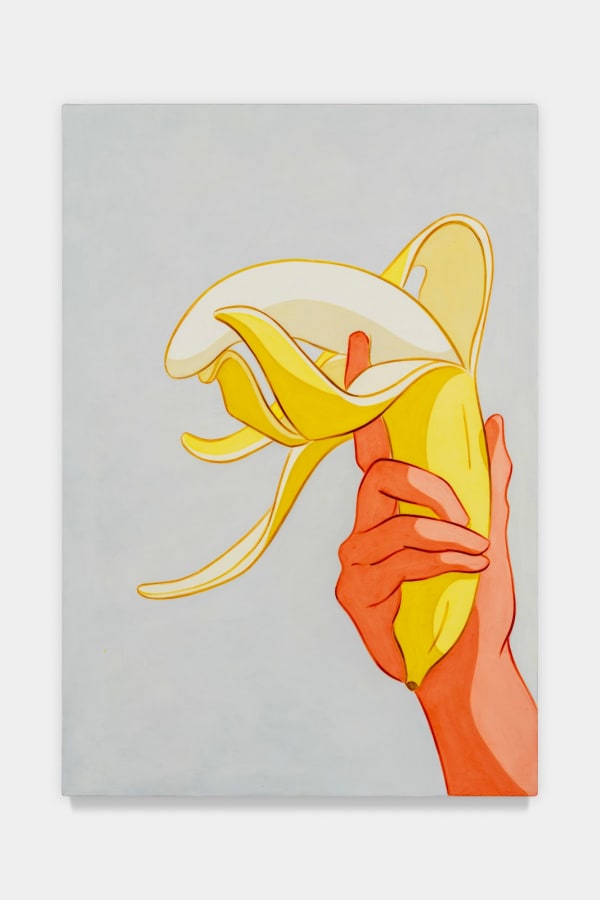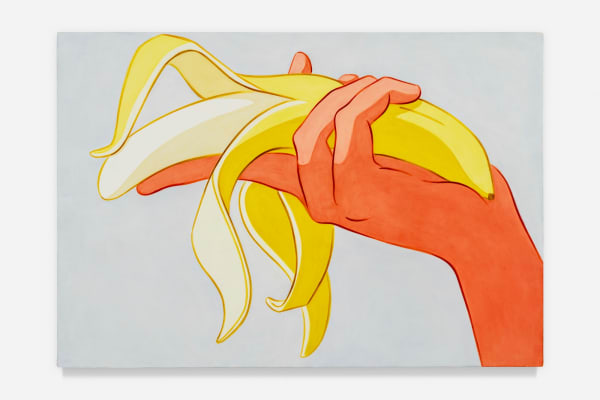Ivy Haldeman: The Agreement, The Fool, and The Storm
François Ghebaly is proud to present The Agreement, The Fool, and The Storm at the gallery’s Downtown Los Angeles location, the newest exhibition by the American visual artist Ivy Haldeman.
Bikini Atoll is a coral reef made up of a ring of islands that sits some 2600 miles southwest of Honolulu and 5000 miles from Los Angeles. In 1946, after decades of German and Japanese imperial control, the United States displaced the atoll’s Marshallese population and began to use the islands as a peacetime nuclear testing site. Over the next twelve years, the U.S. military deployed nearly two dozen hydrogen bombs on land, over the ocean, and in the coral reefs of Bikini.
To keep up with the Soviet nuclear program, the United States set off bigger and bigger explosions in the Pacific. Just as the testing was beginning, a Cold War-era race of reverse scale was launched 8000 miles away when French designer Louis Réard co-opted the atoll’s name to describe yet another mid-century provocation of superlative proportions, one that would come to define gendered aesthetics for decades to come: “the Bikini — smaller than the smallest swimsuit in the world.” In red, pink, and polkadot styles, Réard’s design is a central figure in Haldeman’s newest exhibition, The Agreement, The Fool, and The Storm.
For Haldeman, whose unmistakable visual imaginary spans from titanic hot dog androgynes to cooly gesticulating power suits that evoke 1980’s corporate feminism, the sordid genealogies of the ‘bikini’ are hardly out of bounds. On the contrary, they’re prime targets for Haldeman’s critical acumen and unique sense of empathy. Haldeman’s paintings overlap American visual iconography, history, and underlying commodity fetish with her characteristic gestural styling. Her work seeks to cast a light on — and in many cases dislodge — latent hegemonies.
Notions of ‘slippage’ are at the heart of Haldeman’s art and the exhibition is a study in the push-pull between image and power. Conveyed in the interplay between consumer culture and the surprising interiorities she’s able to carve out in her portrayals, her ‘slips’ become sites of newfound potential. “There’s something about shaking images loose from our expectations,” the artist noted. “We can put emphasis on how we arrived at those expectations in the first place, and on where we might still find some agency.”
Alongside her signature powersuit forms, Haldeman presents three new bodies of work. The first, a collection of massive, mural-esque canvases and small-scale watercolor studies of polychrome bikinis, are titled after tropical storms in the Gulf of Mexico. A far cry from the scantily-clad beach bodies of popular imagination, Haldeman depicts her bikinis in flight with reams of loose leaf paper in enormous gyres. They sail across her sprawling pale blue surfaces as though propelled by violent climate change-induced tempests, or nuclear gales; “I think of the form of the mushroom cloud, up and then out.” In the absence of clear figural centerpoints, the works convey a kind of scalar quality that can be extrapolated far beyond the confines of the canvas. The tumbling sheets of paper recall the 1990s Desert Storm ticker-tape parades captured in Jem Cohen’s Little Flags, an uncanny foreshadowing of the maelstrom in Manhattan skies after 9/11.
In two other series, Hand Hold and Cuffs, Haldeman returns to a more intimate scale and focuses on reciprocal figures and exchanges of power. Hand Hold imagines interactions between a hand and a flamboyant yellow banana. In each work, the hand acts both as a tacit support for the banana figure and also as a constraining or impeding force. The banana, caught in a breeze not unlike the one that blows against Haldeman’s bikinis, serves as a choreographic repository of histrionics and otherwise gendered displays of affectation — a pacified proxy for “unacceptable public emotions.”
In Cuffs, Haldeman turns her attention to the gesture of the ‘handshake’ as a symbol of political theater and collective stakes. “I think of the feeling, the anxiety, as a layperson, of watching political transactions from afar — decisions being made that you have absolutely no say in, and that will also irreversibly change your life and everyone else’s lives. You’re excluded, and you’re also complicit.” For Haldeman, the handshake and other coincidences of intimacy and hegemony become recurring metonyms for the sociopolitical condition of individual responsibility, a condition that is fastidiously baked into our fundamental modes of visual literacy, and against which we might yet hope to forge new channels of solidarity and identification.
From titanic anthropomorphized hot dogs, to phantom skirt-suits and strolling fingers, Ivy Haldeman (b. 1985, Aurora, CO) has spent over a decade cultivating a practice in painting and multimedia sculpture that flexes the psychic power of slippage and transfiguration. Blending elements of psychoanalysis, character study, and visual sociology, Haldeman creates work interested in the mechanisms of commodity fetishism and the interior subjective. Across her work, colossal figures, depicted in clean lines and graphic styling, are cast against the brilliance of titanium dioxide. Their range of physical and emotive states — sensual relaxation, withdrawn repose, casual ennui, electric self-assertion — exemplify Haldeman’s fluency in gestural language, and enrich her figures’ concurrent investments in labor and capital. Interweaving consumerist tropes, ironic conceit, and sensitive, humanist rendering, Haldeman’s practice probes the depths of our capacities of self-recognition.
Haldeman currently works and resides in New York City. She received a BFA from Cooper Union in 2008, and her recent solo exhibitions include Tara Downs (2023, 2021, 2018); the Yuz Museum (2022); François Ghebaly (2020); and Capsule Shanghai (2019). Her work has been exhibited in numerous group exhibitions, including at Petzel Gallery, Hauser & Wirth, Fredericks & Freiser, the Frans Hal Museum, and Paul Kasmin Gallery, among others. She’s been featured in publications including the New York Times, Cultured Magazine, W Magazine, Brooklyn Rail, the New Yorker, and Artforum.
-
 Ivy Haldeman, Bikinis, Upper Tossed, Diagonal Pull, Bottom Corner Tumble (Emily), 2023
Ivy Haldeman, Bikinis, Upper Tossed, Diagonal Pull, Bottom Corner Tumble (Emily), 2023 -
 Ivy Haldeman, Bikinis, Beyond Edge, Straight Ahead, Tilt Back (Don), 2023
Ivy Haldeman, Bikinis, Beyond Edge, Straight Ahead, Tilt Back (Don), 2023 -
 Ivy Haldeman, Bikinis, Lower Near Touch, Turn Right, Backgrounded (Franklin), 2023
Ivy Haldeman, Bikinis, Lower Near Touch, Turn Right, Backgrounded (Franklin), 2023 -
 Ivy Haldeman, Two Suits, Elbows Lock, Lilt Right, Wrists Together (Compose Green, Ultramarine Blue), 2023
Ivy Haldeman, Two Suits, Elbows Lock, Lilt Right, Wrists Together (Compose Green, Ultramarine Blue), 2023 -
 Ivy Haldeman, Fool, 2023
Ivy Haldeman, Fool, 2023 -
 Ivy Haldeman, Two Suits, Sleeves Spread, Torso Down, Look Right (Pyrrole Orange, Cobalt Blue), 2023
Ivy Haldeman, Two Suits, Sleeves Spread, Torso Down, Look Right (Pyrrole Orange, Cobalt Blue), 2023 -
 Ivy Haldeman, Cuffs, Thumb Touches, Index Extends, Pinky Curls, 2023
Ivy Haldeman, Cuffs, Thumb Touches, Index Extends, Pinky Curls, 2023 -
 Ivy Haldeman, Cuffs, Fingers Fan Out, Ring and Middle Catch Thumb, Indices Press, 2023
Ivy Haldeman, Cuffs, Fingers Fan Out, Ring and Middle Catch Thumb, Indices Press, 2023 -
 Ivy Haldeman, Cuffs, Flat Palm to Palm, Indices Enter Sleeves, Thumb Peeks, 2023
Ivy Haldeman, Cuffs, Flat Palm to Palm, Indices Enter Sleeves, Thumb Peeks, 2023 -
 Ivy Haldeman, Hand Hold, Index Up, Fruit Bends, Breeze, 2023
Ivy Haldeman, Hand Hold, Index Up, Fruit Bends, Breeze, 2023 -
 Ivy Haldeman, Hand Hold, Wrist Bent Back, Middle Supports, Peel Droops, 2023
Ivy Haldeman, Hand Hold, Wrist Bent Back, Middle Supports, Peel Droops, 2023 -
 Ivy Haldeman, Hand Hold, Thumb Splits Peel, Hand Covers, Peels Flail, 2023
Ivy Haldeman, Hand Hold, Thumb Splits Peel, Hand Covers, Peels Flail, 2023 -
 Ivy Haldeman, Agreement, 2023
Ivy Haldeman, Agreement, 2023 -
 Ivy Haldeman, Storm, 2023
Ivy Haldeman, Storm, 2023
-

Notions of Slippage
Evan Pricco, Juxtapoz, June 11, 2024 -

How the Painter Ivy Haldeman Critiques Consumerism With Hot Dogs
Genesis Belanger, Interview, July 3, 2023 -

In Her Light-Drenched Waterfront Studio, Ivy Haldeman Paints Toward an ‘Empathetic Pang,’ Pausing for Noodle Breaks
Katie White, Artnet, May 30, 2023 -

Hello, the Future Is Certain: Ivy Haldeman @ François Ghebaly, Los Angeles
Juxtapoz, October 6, 2020
